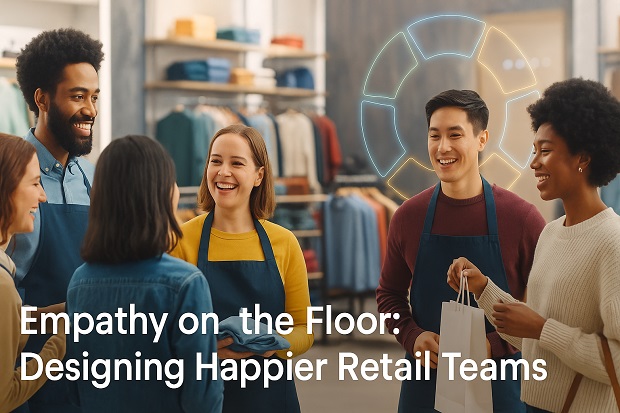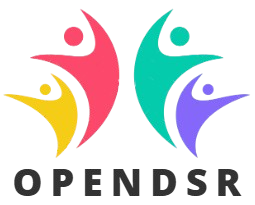
OPENDSR for Retail: Creating Happier Store Teams
The Human Side of Retail
Walk into any store, and you’ll feel it within seconds: the pulse of the people behind the counter.
They are the face of the brand, the bridge between promise and purchase.
Yet, in one of the most human industries, employee experience often gets lost behind operations and sales metrics.
Turnover is high. Burnout is frequent. Communication feels one-way.
And yet—these are the very people who shape customers’ first impressions.
If employees feel invisible, how can they make customers feel seen?
That’s why the retail sector needs OPENDSR—a framework that helps organizations move beyond transactional management to empathetic, structured, and data-driven experience design.
The Retail Reality: High Turnover, Low Voice
Retail has always been fast-paced. But post-pandemic, it became relentless.
Schedules shift hourly, expectations rise daily, and digital systems multiply.
Common challenges:
- High attrition: Frontline turnover averages 60–70% annually.
- Communication gaps: Store teams feel disconnected from head office decisions.
- Limited growth: Few structured career paths beyond store roles.
- Burnout: Emotional labour often goes unnoticed or unrewarded.
These factors quietly erode both morale and brand loyalty.
As one store manager put it:
“We get daily updates on sales targets—but no updates on how people feel.”
OPENDSR changes that dynamic by embedding empathy into every store, schedule, and system.
What OPENDSR Brings to Retail
OPENDSR—Operating Principles for Empathy-led Navigation, Design Standards, and Real-time Intelligence—gives retailers a human-centric operating model for experience.
Instead of running engagement campaigns once a year, retail leaders can use OPENDSR to continuously:
- Listen to frontline signals.
- Identify friction points quickly.
- Co-create better store experiences.
- Standardize empathy across shifts and formats.
- Refine practices using real-time insights.
The framework’s 7-step operating cycle makes this possible even in large, dispersed retail networks.
The 7-Step OPENDSR Cycle for Retail
Step
Retail Application
1. Observe 👀
Capture real employee signals—shift morale, workload feedback, customer stress.
2. Prioritize 🎯
Focus on top friction points (e.g., scheduling, recognition, manager communication).
3. Envision 🧠
Co-design better workflows and wellbeing rituals with store teams.
4. Navigate 🗺️
Build practical action roadmaps—by store, by week, by role.
5. Design ✏️
Create clear standards for daily huddles, recognition, and feedback.
6. Systematize ⚙️
Automate check-ins and pulse surveys via existing retail tech.
7. Refine 🔄
Review every month—what’s working, what’s burning out, what needs care.
Step 1: Observe – Seeing the Shift Experience
Retail leaders often rely on numbers—conversion, footfall, upsell.
But numbers don’t tell you if employees are tired, unheard, or proud.
OPENDSR’s Observe phase introduces micro-listening:
- 15-second pulse surveys after each shift.
- Anonymous feedback kiosks in staff areas.
- Quick sentiment capture via WhatsApp or Teams bots.
Patterns emerge:
- Morning shifts show low energy → scheduling fatigue.
- Weekend peaks show emotional stress → staffing imbalance.
- Recognition drops after sales rush → burnout cycle.
Observation replaces assumption with human data.
Step 2: Prioritize – Fixing What Hurts First
Retail teams face dozens of issues daily, but not all are equal.
OPENDSR helps prioritize high-impact frictions through Experience Heat Mapping.
Example:
- Long queues = stress → operations fix.
- Inconsistent scheduling = fatigue → experience fix.
- Lack of recognition = morale dip → culture fix.
A global apparel chain applied OPENDSR prioritization and learned that manager tone during shift briefings affected morale more than overtime pay.
A few weeks of training and empathy prompts increased satisfaction scores by 27%.
Step 3: Envision – Co-Designing Better Shifts
The Envision step invites employees to re-imagine their daily flow.
Through short co-creation sessions or digital idea boards, store associates help design:
- Empathy rituals: e.g., “Shift Huddles” where managers ask, “How’s your energy today?”
- Flexible micro-breaks: for recovery between peak hours.
- Feedback walls: staff post quick “what’s working / what’s tough.”
- Recognition swaps: peer-to-peer shout-outs after closing time.
When frontline employees help shape experience design, they own it—and live it.
“We stopped asking for engagement and started designing it together.”
Step 4: Navigate – Making Empathy Operational
Retail thrives on clarity.
OPENDSR’s Navigate phase creates Experience Roadmaps—visual guides that outline exactly when and how to act.
A sample weekly roadmap:
Day
Ritual
Owner
Monday
Team pulse check (2 mins)
Store Manager
Wednesday
“Customer Story” sharing
Shift Lead
Friday
Recognition shout-outs + wellbeing check
HR Partner
Monthly
“Friction Fix Review”
Regional Manager
These micro-rhythms create predictability, which builds psychological safety.
When people know when their voices will be heard, they don’t have to shout to be noticed.
Step 5: Design – Standards That Make Every Store Feel Human
Retail consistency isn’t just for product—it’s for people, too.
In OPENDSR’s Design step, organizations create Experience Standards like:
- 5-Minute Daily Huddle Template (tone, empathy cues, recognition).
- Role Cards for new hires explaining “how your work creates smiles.”
- Inclusive Recognition Boards for peer nominations.
- Calm Corner Guidelines—quiet zones for brief mental reset.
Designing these standards ensures empathy doesn’t depend on who’s managing—it’s part of how you manage.
“Design makes empathy repeatable.”
Step 6: Systematize – Automating Care and Clarity
Retail operations thrive on rhythm—so why not automate engagement?
With OPENDSR’s Systematize phase:
- Auto-pulse messages go out post-shift via WhatsApp or Teams.
- Recognition bots tag top performers each week.
- EX Dashboards show store mood trends.
- Micro-learning nudges remind managers to check in, not just check boxes.
A supermarket chain used Power Automate + Viva Engage to systematize these rituals:
- Engagement rose 32%.
- Absenteeism fell 18%.
- Manager response time to feedback improved by 44%.
Step 7: Refine – Continuous Improvement from the Ground Up
Retail experiences change daily; OPENDSR keeps improvement alive.
Every month, each store conducts a Refinement Review:
- What boosted morale this month?
- What created stress?
- What’s one improvement we’ll pilot next?
Feedback rolls upward into regional dashboards, closing the loop.
No idea is wasted—small learnings scale across hundreds of stores.
This continuous feedback rhythm transforms retail from reactive to responsive.
“We stopped managing morale. We started maintaining momentum.”
Case Study: OPENDSR in a Global Retail Chain
Challenge:
A 700-store fashion retailer faced 62% turnover and low engagement scores.
Employees cited “no recognition,” “rigid scheduling,” and “no voice.”
Solution with OPENDSR:
- Observe: Shift-wise pulse tracking captured morale dips on weekends.
- Prioritize: Top friction—manager communication and inflexible rosters.
- Envision: Co-designed flexible scheduling pilot with 10 stores.
- Navigate: Built weekly “EX Rhythm Map.”
- Design: Introduced standardized huddles and recognition rituals.
- Systematize: Used SharePoint + Teams for automated surveys and recognition boards.
- Refine: Adjusted schedules monthly based on employee sentiment.
Results (6 months):
- Attrition dropped from 62% → 38%.
- Engagement scores rose +29 points.
- Customer satisfaction up 18%.
- Cross-store collaboration improved visibly.
Voices from the Floor
“We finally feel heard. Even a two-minute pulse makes a difference.”
— Store Associate, Electronics Retailer
“OPENDSR helped us connect head office strategy to shop-floor reality.”
— Regional Manager
“It turned engagement into a daily habit, not an annual report.”
— HR Business Partner
Frontline voices are the most powerful proof that experience is the new driver of performance.
The Tangible Impact of OPENDSR in Retail
KPI
Average Improvement
Measured Over
Attrition Rate
↓ 25–40%
6 months
Shift Engagement Score
↑ 30–35%
Quarterly pulse
Customer Satisfaction (CSAT)
↑ 15–20%
Store surveys
Absenteeism
↓ 18%
3 months
Recognition Participation
↑ 50%
Ongoing
Manager Responsiveness
↑ 40%
Real-time data
The result: happier people, stronger performance, and measurable brand trust.
Integrating OPENDSR with Retail Systems
Retail runs on complex digital ecosystems—POS, HRMS, scheduling, and intranet tools.
OPENDSR integrates smoothly across them:
- CorporateOne (SharePoint EX platform): hosts recognition boards, feedback dashboards, and wellbeing journals.
- Microsoft Teams / Viva Engage: enables pulse check bots and digital shout-outs.
- Power BI: tracks real-time morale across stores and regions.
- HRIS integration: triggers onboarding, feedback, and learning flows.
This allows experience management to live inside the tools employees already use, not outside them.
From Turnover to Togetherness
Retail doesn’t need more dashboards—it needs more design.
It needs structures that put empathy on schedule, recognition in workflow, and reflection in routine.
OPENDSR offers a roadmap for that transformation.
By connecting daily human energy with operational intelligence, it helps every store become a culture hub.
“In retail, experience is the product—inside and out.”
When frontline teams feel seen, customers feel served.
That’s how retail wins—through human rhythm, not just retail rhythm.








